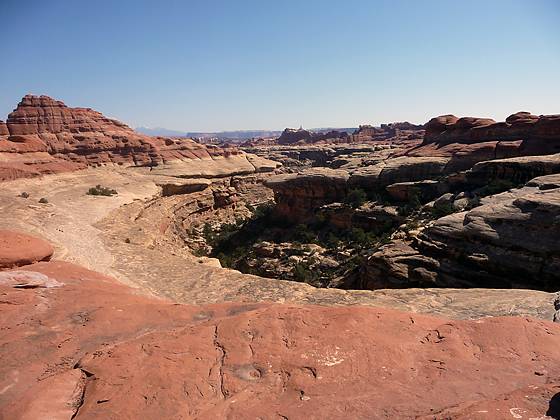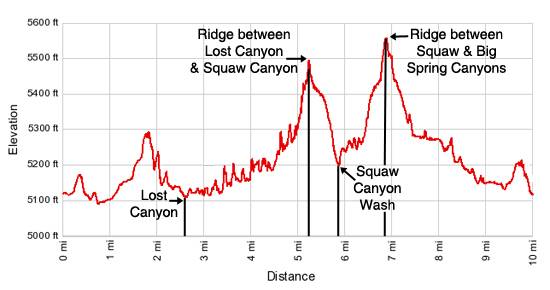Details: Lost Canyon/Big Spring Canyon Loop 
Distance: 8.7 - 10.0 miles (loop)
Needles District, Canyonlands National Park, near Canyonlands in Southeast Utah
Hike Facts
- Distance: 8.7 - 10.0 miles (loop)
- Elevation: 5,122-ft. - 5,584-ft.
- Elevation Gain: 840-ft.
- Difficulty: strenuous
- Trail Highlights: See Trail Intro
- Basecamp(s): Canyonlands / Monticello
- Region: Southeast Utah

Spectacular canyon scenery awaits hikers on this varied loop hike traversing sandy washes, climbing slickrock benches and crossing steep sandstone ridges as it travels through three scenic canyons.
Trailhead to Squaw Canyon
Distance from Trailhead: 8.7 miles (loop)
Ending/Highest Elevation: 5,500-ft.
Elevation Gain: 378-ft.
The Squaw Flats trailhead is located along the south side of the Squaw Flats Loop “A” road. From the trailhead, walk south for 200-ft. to a trail junction. To the left is the trail to Squaw Canyon, Lost Canyon and Peekaboo Springs. To the right is the path to Big Spring Canyon. The loop can be done in either direction. I describe the loop in a clockwise direction, going up Lost Canyon and returning via Big Spring Canyon. The route between the two canyons climbs steep grades into and out of the upper end of Squaw Canyon.
To walk the loop in the clockwise direction turn left (southeast) at the junction in the direction of Squaw and Lost Canyons. The trail travels across flat, scrub covered desert terrain for 0.2 miles to a low sandstone ridge. Rock cairns mark the trail crossing the ridge. At the top of the ridge enjoy nice views of the slickrock formations rising to the north of the campground and the La Sal Mountains to the northeast.
Beyond the ridge the trail continues across the scrub covered desert scattered with Utah Junipers to the junction with the Squaw Canyon trail, branching to the right, one mile from the trailhead. Take the left fork toward Lost Canyon and Peekaboo Springs.
Past the junction the trail follows a gently ascending traverse across scrub flats before arriving at a second sandstone ridge at 1.6 miles. Rock cairns mark the short, steep climb to the top of the ridge where views open in all directions to a world of colorful sandstone formations.
The cairned trail now curves to the left (east/southeast) as it descends along the ridge’s slickrock slopes to the bottom of a minor unnamed canyon. A metal ladder aids a portion of the descent. Carefully follow the rock cairns along this section of the trial. When following cairns it is always best to look ahead and find the next cairn before proceeding.
In the canyon the trail travels along the wash for a short distance and then proceeds over scrub covered benches to the junction with the Lost Canyon Trail at 2.5 miles. Turn right (south/southwest) on the Lost Canyon trail. The Peekaboo trail continues straight ahead (southeast). (Note: Lost Canyon campsite #1 is located a short distance beyond the junction along the Peekaboo trail.)
The Lost Canyon trail gently ascends along the canyon bottom, frequently crossing the wash and climbing the adjacent benches to cutoff meanders in the canyon’s sinuous course. At 3.3 miles pass Lost Canyon campsite #2 on you right. An undercut along the western side of the wash near the campsite may contain a nice pool of water during the spring or after a rain storm.
As you continue hiking upstream the canyon narrows and becomes more vegetated. During the spring or after a rain storm you may pass pools of water and sections of running water in the wash. Occasionally obstacles in the wash or brushy sections along well watered sections of the canyon temporarily force the trail to climb high on the adjacent benches.
Just beyond Lost Canyon campsite #3, 4.4 miles from the trailhead, the trail enters a narrow, heavily vegetated side canyon. The path exits the wash at 4.9 miles, following a cairned trail that climbs steeply up ledges on the canyon’s north wall and then ascends steep slickrock slopes to a saddle on the sandstone ridge separating Lost and Squaw Canyons. Be sure to carefully follow the rock cairns. There are quite a few twists and turns on the lower section of the route climbing out of the canyon.
From the saddle enjoy the spectacular panoramas of colorful sandstone fins, spires and hoodoos towering above the deep canyons. On a clear day wonderful vistas extend to the northeast and northwest.
After soaking in the views continue on the trail as it heads right (north), descending moderately steep slickrock slopes into Squaw Canyon. The upper section of the trail enjoys great views of the multi-hued terra-cotta and white ridges to the south/southwest.
As you descend the trail drops off the ridge and climbs down a sandstone bench with scattered junipers growing amid small pockets of soil. Soon the trail enters a side canyon, descending slickrock chutes and down a rocky trail to the Squaw Canyon wash, 5.9 miles from the trailhead. (During the spring months the wash at Squaw Canyon may contain water.) Just before reaching the wash the trail passes a spur trail to Squaw Canyon campsite #2.
On the other side of the wash is a signed trail junction. Turn left (southwest) and head up Squaw Canyon. There is also a sign pointing in the same direction toward Druid Arch. The trail to the right goes down Squaw Canyon and back to the Squaw Flats campground in 2.8 miles. (If you are feeling hot and tired this is a good place to shorten the loop. Total distance for the shorter loop is 8.7 miles.)
Squaw Canyon to Big Spring Canyon
Distance from Trailhead: 10.0 miles (loop)
Ending/Highest Elevation: 5,584-ft.
Elevation Gain: 840-ft.
The trail up Squaw Canyon ascends on easy grades along the bench on the west side of the canyon. At 6.4 miles the climb steepens as the cairned trail ascends a rocky bench and sandstone ledges to a trail junction, 6.8 miles from the trailhead. Here old wooden signs point left toward Druid Arch and right for the trail to Big Spring Canyon.
Turn right and follow a cairned trail that climbs very steeply up slickrock slopes, traversing a narrow chute along the way, to saddle on the ridge between Squaw and Big Spring Canyons. Toe holes dug into the slickrock facilitate the climb up a particularly steep section of the ridge.
Massive sandstone fins rise above either side of the saddle. Views from this lofty spot encompass a stunning landscape of sculpted rock spires, monoliths and fins rising above the sinuous canyons. In the distance are massive red rock mesas and buttes.
The initial descent from the saddle, marked by rock cairns, is quite steep but soon moderates as the trail reaches a sandstone bench studded with pinion pines and junipers. Soon the trail drops into a narrow drainage that meets the main wash in Big Spring Canyon, 7.7 miles from the trailhead. Be sure to turn around during the descent for great views of the rock formation rising above the head of the canyon.
Follow the trail as it descends Big Spring Canyon on easy grades, traveling northeast along the wash and then traversing the sandy, vegetated benches on the east side of the canyon. During the spring you may see some water in the wash.
At 8.4 miles the trail passes Big Spring Campsite #2 on the left. In the lower end of the canyon, which is noticeably drier, the trail passes by some interesting freestanding mushroom shaped towers.
Reach a trail junction at 9.4 miles. Continue straight ahead toward Squaw Flats. The trail branching to the left (southwest) leads to Chesler Park and Druid Arch. The spur trail to Big Spring Campsite #1 is located just past the junction.
Beyond the junction the path ascends a scrub covered bench and soon arrives at another trail junction at 9.7 miles. To the left is the trail to Squaw Flats Campground B. Turn right in the direction of Squaw Flats Campground A and follow the trail as it crosses a low sandstone ridge. Scenic views from the top of the ridge encompass the Needles to the southwest and the La Sal Mountains to the northeast.
Drop off the ridge and travel on easy grades across scrub covered flats back to the Squaw Flats trailhead. Total distance for the loop hike is 10.0 miles.
Elevation Profile

Driving Directions
From Moab, UT: Drive south on U.S. Highway 191 for roughly 40 miles to Utah Highway 211 (signed for Canyonlands National Park, Needles District) and turn right (west). Follow Utah Highway 211 west for 37.2 miles and turn left (west), on the road signed for the Squaw Flat Campground. The turn is located 2.8 miles beyond the Visitor Center. At the first intersection (0.3 miles) continue straight ahead on the Campground Loop A road for 0.9 miles. (Do not turn right onto the Campground Loop B road.) The parking area for the Squaw Flat Trailhead is located on the left (south) side of the road.
From Monticello, UT: Drive north on U.S. Highway 191 for roughly 14.3 miles to Utah Highway 211 (signed for Canyonlands National Park, Needles District) and turn left (west). Follow Utah Highway 211 west for 37.2 miles and turn left (west), on the road signed for the Squaw Flat Campground. The turn is located 2.8 miles beyond the Visitor Center. At the first intersection (0.3 miles) continue straight ahead on the Campground Loop A road for 0.9 miles. (Do not turn right onto the Campground Loop B road.) The parking area for the Squaw Flat Trailhead is located on the left (south) side of the road.
From Blanding, UT: Drive north on U.S. Highway 191 for roughly 34.8 miles to Utah Highway 211 (signed for Canyonlands National Park, Needles District) and turn left (west). Follow Utah Highway 211 west for 37.2 miles and turn left (west), on the road signed for the Squaw Flat Campground. The turn is located 2.8 miles beyond the Visitor Center. At the first intersection (0.3 miles) continue straight ahead on the Campground Loop A road for 0.9 miles. (Do not turn right onto the Campground Loop B road.) The parking area for the Squaw Flat Trailhead is located on the left (south) side of the road.
Trail Resources
Trail Intro / Trail Photo Gallery / Trail Map
Basecamp(s) Information:
Canyonlands / Monticello
Region Information:
Southeast Utah
Other Hiking Regions in:
Utah